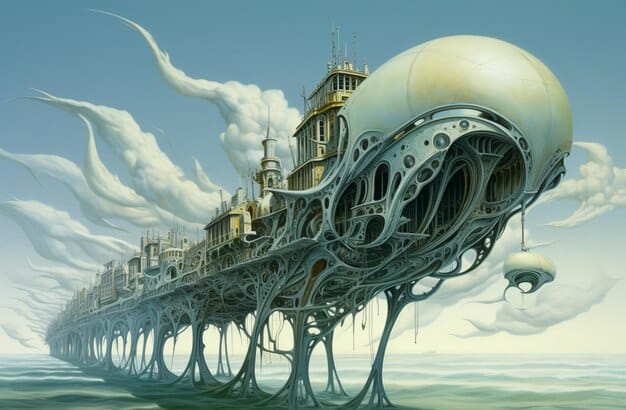The Rise of Cli-Fi: Understanding Climate Fiction’s Growing Importance

Exploring the burgeoning literary genre of cli-fi, or climate fiction, this article delves into its emergence, critical importance as a narrative tool for addressing climate change, its literary merits, and its growing influence on global environmental discourse and public understanding of ecological crises.
In an era increasingly defined by environmental introspection, the literary world has seen a profound narrative shift, giving rise to a genre that directly confronts our epoch’s defining challenge: climate change. This phenomenon, known as The Rise of Cli-Fi: Understanding Climate Fiction’s Growing Importance and Literary Merit, offers a unique lens through which to explore humanity’s past, present, and potential futures amidst ecological upheaval, transcending mere storytelling to become a vital cultural touchstone in our collective response to global warming.
The evolving landscape of environmental narratives
The literary world has always reflected societal concerns, and as climate change moves from scientific reports to everyday consciousness, narratives are adapting. Environmental storytelling isn’t new, but its current iteration—cli-fi—presents a deeper, more urgent engagement with the topic, moving beyond simple advocacy to complex explorations of human experience within ecological crises. This genre’s evolution signifies a collective cultural reckoning with environmental realities, giving voice to anxieties and hopes that scientific papers cannot fully convey.
From early eco-literature to modern cli-fi
Early environmental literature often depicted nature as pristine, either to be conserved or threatened by human intrusion. Think of works that championed natural beauty or warned against industrial encroachment. However, modern cli-fi differs significantly, often portraying a world already grappling with the consequences of climate change, not just its causes. The narratives are less about preserving a pristine past and more about navigating a challenging present or a potentially dystopian future.
- Early Roots: Focused on nature’s beauty and man’s destructive impact (e.g., Thoreau, Leopold).
- Transitional Works: Introduced themes of pollution and resource depletion (e.g., Rachel Carson’s Silent Spring, though not fiction, heavily influenced the narrative).
- Emergence of Cli-Fi: Explores direct societal and individual consequences of climate breakdown (e.g., Margaret Atwood’s Oryx and Crake).
This transition reflects a deepening understanding of environmental issues, moving from appreciation and early warnings to a more immediate and visceral engagement with systemic collapse and adaptation. Authors grapple with complex ethical dilemmas and the psychological toll of living in a world transformed by human actions. The stories serve as both warnings and potential roadmaps for survival and resilience, offering readers a space to process difficult truths.
The shift is particularly noticeable in how human characters interact with their environment. Where historical works might feature humans as outsiders observing nature, cli-fi often places characters directly within compromised ecosystems, forcing them to confront the tangible effects of environmental degradation on their immediate lives. This proximity fosters a more intimate and often more disturbing narrative. The narratives explore not just the physical changes, but also the societal, political, and psychological transformations brought about by a changing climate.
Defining cli-fi: More than just a subgenre
Cli-fi, short for climate fiction, is a genre that specifically addresses climate change and global warming, often exploring the consequences of these phenomena on human society and the natural world. It is distinct from broader environmental fiction in its explicit focus on anthropogenic climate alteration as a central plot element, rather than merely a backdrop. Its purpose extends beyond entertainment, aiming to provoke thought, foster empathy, and sometimes even inspire action. The genre encompasses a wide range of styles, from speculative to realistic, but always with a strong thematic anchor in climate issues.
Key characteristics of climate fiction
Cli-fi often features scenarios of ecological collapse, extreme weather events, resource scarcity, and mass migration. However, it’s not exclusively dystopian; some cli-fi explores resilience, adaptation, and even optimistic visions of a sustainable future. What unites these diverse narratives is their engagement with the scientific realities of climate change and their extrapolation into human experience. The best cli-fi integrates scientific principles seamlessly into compelling human stories, making abstract data feel immediate and personal.
- Centrality of Climate Change: The plot, characters, and settings are fundamentally shaped by climate-related issues.
- Exploration of Consequences: Delves into the societal, economic, psychological, and ecological impacts of environmental shifts.
- Speculative or Realistic: Can range from near-future realism to distant, post-apocalyptic scenarios.
- Human Element: Focuses on how individuals and communities respond to environmental crises.
The genre serves as a cultural repository for anxieties and hopes concerning the planet’s future, allowing authors to explore complex ethical dilemmas and technological solutions. It challenges readers to consider their own roles and responsibilities in shaping environmental outcomes. Whether portraying a world struggling to survive or one finding innovative ways to thrive amidst adversity, cli-fi foregrounds the human capacity for both destruction and adaptation. Authors often use the genre to critique current environmental policies, societal attitudes, or technological dependencies, offering a mirror to contemporary issues.
The scope of cli-fi is broad, encompassing various literary forms and narrative structures. It can be found in literary fiction, science fiction, thrillers, and even children’s literature, demonstrating its versatility and growing mainstream appeal. This widespread adoption indicates a maturing of environmental themes within literature, evolving from niche concerns to central narratives reflecting universal human experiences.
The power of narrative: Why cli-fi matters
In an age saturated with scientific reports and data, cli-fi offers a vital, complementary approach to understanding climate change. It transforms abstract scientific concepts into relatable human stories, making the complex and often overwhelming realities of environmental degradation accessible and emotionally resonant. By engaging the imagination, cli-fi can foster empathy, illuminate consequences, and even inspire action in ways that purely factual presentations might struggle to achieve.
Translating science into human experience
One of cli-fi’s most significant contributions is its ability to bridge the gap between scientific understanding and public perception. Climate change often feels distant and abstract, a problem for future generations or remote polar regions. Cli-fi brings it home, illustrating how rising sea levels or extreme droughts impact individual lives, communities, and cultures. This narrative translation helps people visualize potential futures and understand the personal stakes involved. It provides a means for readers to emotionally process what otherwise might remain intellectual knowledge, creating a deeper connection to the material.
Authors use character-driven plots and vivid world-building to explore themes like displacement, resource conflict, technological adaptation, and psychological resilience in the face of environmental collapse. This human scale makes the global problem tangible, fostering a sense of urgency without resorting to didacticism. By showing, rather than just telling, cli-fi can be a powerful tool for social commentary and imaginative projection. It allows readers to inhabit challenging futures, prompting them to consider how present actions might shape those realities.
Fostering empathy and inspiring action
Beyond mere understanding, cli-fi can cultivate empathy, an essential ingredient for collective action. By immersing readers in the lives of characters struggling with climate-induced challenges, the genre encourages them to consider perspectives beyond their own. This empathetic connection can motivate readers to engage with environmental issues on a personal and political level. Stories have a unique capacity to move people, and cli-fi leverages this power to drive engagement. It transforms statistics into narratives, making the impending crisis relatable and urgent.
Through its exploration of diverse futures—both bleak and hopeful—cli-fi prompts readers to contemplate ethical choices and potential solutions. It can highlight the interconnectedness of human actions and ecological outcomes, encouraging a sense of responsibility. Whether depicting a cautionary tale or a path to resilience, cli-fi plays a crucial role in shaping public discourse around climate change, encouraging a more thoughtful and proactive approach. The emotional investment fostered by these narratives can extend into real-world advocacy, transforming passive understanding into active participation in climate solutions.

Literary merit: Crafting compelling climate narratives
The growing recognition of cli-fi extends beyond its thematic relevance; it is increasingly celebrated for its literary depth and innovative storytelling. Far from being formulaic or purely didactic, the genre has attracted acclaimed authors who bring sophisticated narrative techniques, complex character development, and profound philosophical inquiry to their environmental themes. This literary evolution ensures that cli-fi resonates as powerful art, not just as socio-political commentary.
Diverse narrative approaches and stylistic innovation
Cli-fi employs a broad spectrum of narrative styles, reflecting the multifaceted nature of the climate crisis itself. Authors experiment with structure, voice, and perspective to capture the varied impacts of environmental change. Some craft intricate, multi-generational sagas that trace the long-term consequences of degradation, while others focus on intimate, character-driven studies of individual resilience. The stylistic diversity within cli-fi is a testament to its artistic vitality, moving beyond traditional science fiction tropes.
- Experimental Structures: Non-linear timelines, multiple viewpoints, and fragmented narratives to reflect environmental disruption.
- Psychological Realism: Deep dives into characters’ emotional and mental states as they confront environmental loss and uncertainty.
- Speculative World-building: Creating richly imagined future environments that are scientifically plausible yet artistically evocative.
- Genre Blending: Incorporating elements of mystery, thriller, romance, and historical fiction to broaden appeal and thematic scope.
This innovation helps to prevent the genre from becoming repetitive, ensuring fresh perspectives on urgent themes. Authors often tackle ethical dilemmas arising from climate change, such as climate migration, geoengineering, and resource conflicts, imbuing their narratives with moral complexity. The literary craftsmanship ensures that these stories are not only informative but also profoundly moving, leaving a lasting impression on readers. By refusing to conform to a single narrative mold, cli-fi continues to evolve, pushing the boundaries of what environmental literature can achieve.
Character development and thematic depth
At its core, compelling cli-fi features richly developed characters whose lives are inextricably linked to the unfolding environmental drama. These characters navigate personal struggles alongside global crises, making the abstract consequences of climate change feel deeply personal. Authors explore themes of loss, adaptation, hope, despair, and interconnectedness, often revealing the profound psychological and social impacts of a changing world. It’s through these human journeys that the larger environmental narrative gains its emotional weight.
The thematic depth of cli-fi is further enhanced by its engagement with complex ethical questions. Should humanity prioritize survival at any cost? What does it mean to be resilient in a collapsing world? How do we balance technological solutions with ecological preservation? These questions are explored not through simple answers, but through the nuanced experiences of characters facing impossible choices. This intellectual rigor elevates cli-fi beyond simple entertainment, positioning it as a significant contributor to contemporary literary thought. The best cli-fi reflects the ambiguities and uncertainties of our own time, offering no easy solutions but instead posing vital questions.
Challenges and opportunities for cli-fi authors
Despite its growing importance, cli-fi faces unique challenges, balanced by significant opportunities that position the genre for continued growth and impact. Authors must navigate the complexities of scientific accuracy, avoid didacticism, and engage a public that may already feel overwhelmed by climate news. Yet, the urgency of the topic also provides a powerful impetus for creative exploration and broad readership.
Avoiding didacticism and maintaining artistic integrity
One of the primary challenges for cli-fi authors is to integrate complex environmental themes without sacrificing narrative integrity or becoming overtly preachy. The risk of delivering a lecture rather than a story is ever-present. Successful cli-fi weaves its climate message seamlessly into the plot and character arcs, allowing the narrative to convey the urgency rather than explicit instruction. This requires a delicate balance between factual grounding and imaginative storytelling, ensuring the message emerges organically from the human drama.
Authors must resist the temptation to simplify complex scientific issues for the sake of narrative convenience, while also making them accessible. The goal is to inform and provoke thought, not to present a scientific paper in disguise. Maintaining artistic integrity means prioritizing compelling characters, intricate plots, and powerful prose, allowing the environmental themes to resonate naturally without overpowering the narrative. It is through authentic human experience that the genre achieves its greatest impact, making abstract climate data feel real.
Reaching diverse audiences and inspiring hope
Another significant opportunity for cli-fi lies in its potential to reach audiences that may be resistant to traditional climate messaging. By using the universal appeal of storytelling, cli-fi can bypass political polarization and engage readers on an emotional level. This genre can introduce individuals to climate concepts they might otherwise ignore, making them more receptive to information and potential solutions. The power of narrative to bridge divides is one of cli-fi’s strongest assets.
Furthermore, while cli-fi often explores grim futures, there is an increasing trend toward narratives that embody hope, resilience, and actionable solutions. These “solarpunk” and “hopepunk” subgenres within cli-fi demonstrate humanity’s capacity for adaptation, innovation, and collective problem-solving. By offering visions of a better, sustainable future, authors can inspire optimism and empower readers to envision a path forward, rather than succumbing to despair. This balancing act—acknowledging the severity of the crisis while offering pathways to hope—is crucial for the genre’s long-term effectiveness. These hopeful narratives transform passive consumption into active engagement, offering blueprints for a more sustainable future.

The future of cli-fi: Growing influence and evolving themes
The trajectory of cli-fi suggests a future of continued expansion and deepening influence. As climate change increasingly impacts daily life worldwide, the need for narratives that make sense of these complex realities will only grow. The genre is poised to become a cornerstone of contemporary literature, evolving in response to new environmental challenges and scientific discoveries, further cementing its role in global cultural discourse.
Expanding beyond traditional literary boundaries
Cli-fi is already demonstrating a remarkable capacity to expand beyond traditional literary forms, permeating other media. Films, television series, video games, graphic novels, and even interactive digital experiences are adopting cli-fi themes, bringing climate narratives to broader, more diverse audiences. This cross-media pollination enhances the genre’s cultural footprint and ensures its themes remain relevant and accessible. Its adaptability reflects the universal urgency of its subject matter, pushing creative boundaries.
- Film and Television: Shows like “Extrapolations” and films like “Don’t Look Up” bring climate narratives to mainstream visual media.
- Video Games: Games like “Frostpunk” explore survival and societal choices in extreme climate scenarios.
- Graphic Novels: Visual storytelling offers a compelling medium for depicting altered landscapes and future societies.
- Interactive Media: New digital platforms allow immersive experiences that simulate climate impacts.
This expansion signifies not just a trend but a fundamental shift in how societies engage with environmental issues through storytelling. The accessibility offered by diverse media formats ensures that cli-fi’s vital messages reach populations globally, fostering a more informed and engaged public. As technology evolves, so too will the ways cli-fi is conceptualized and consumed, making its impact ever more pervasive. Authors are likely to continue experimenting with multi-platform storytelling, creating comprehensive narrative ecosystems.
Responding to new environmental realities and scientific insights
The nature of climate change is dynamic, with new scientific insights and unfolding environmental realities constantly emerging. Cli-fi, by its very nature, must remain responsive to these developments. As understanding of climate impacts deepens—from tipping points to geoengineering ethics—the themes and narratives within cli-fi will continue to evolve, reflecting the latest science and societal concerns. This ensures the genre remains critically relevant and forward-looking, acting as a cultural barometer for our changing planet.
Future cli-fi may delve deeper into topics like climate justice, the psychological toll of ecological grief, or the complexities of large-scale environmental restoration efforts. It may also explore solutions-oriented narratives with more scientific precision, inspiring tangible actions. The genre’s ability to adapt and incorporate evolving scientific understanding will be crucial to its continued impact and literary value, ensuring it remains at the forefront of environmental discourse. This ongoing evolution ensures that cli-fi remains not just a reflection of current anxieties but also a proactive force in imagining future possibilities.
The genre will likely continue to explore the intricate relationships between human behavior, technological advancement, and ecological outcomes, always pushing the boundaries of imaginative possibility while remaining grounded in scientific reality. By doing so, cli-fi will further solidify its position as an indispensable component of contemporary literature, offering insights into humanity’s most pressing challenge.
| Key Point | Brief Description |
|---|---|
| 🌍 Defining Cli-Fi | A genre explicitly focused on climate change and its consequences, distinct from broader eco-fiction. |
| 🗣️ Narrative Power | Translates complex science into relatable human stories, fostering empathy and potential action. |
| ✍️ Literary Merit | Characterized by diverse narrative approaches, stylistic innovation, and deep thematic exploration. |
| 🌱 Future Trajectory | Poised for continued growth, expanding across media and evolving with new environmental realities. |
Frequently asked questions about cli-fi
Cli-fi, or climate fiction, is a genre specifically centered on anthropogenic climate change and its consequences. While overlapping with science fiction in its speculative nature, cli-fi distinguishes itself by its explicit focus on the environmental crisis as a direct plot driver, rather than a broad futuristic setting. It often grounds its narratives in scientific plausibility, exploring realistic societal and ecological impacts of climate shifts, aiming for a direct engagement with our current planetary challenges.
Cli-fi translates complex scientific data and abstract concepts of climate change into relatable human narratives. By doing so, it fosters empathy, allowing readers to visualize the personal and societal impacts of environmental degradation. This narrative approach can make the crisis more immediate and understandable, potentially motivating readers to engage with climate issues on a deeper emotional and intellectual level, leading to increased awareness and even advocacy for solutions.
No, not all cli-fi novels are dystopian. While many do explore bleak, post-apocalyptic or near-future scenarios shaped by environmental collapse, a growing subgenre focuses on “solarpunk” or “hopepunk” narratives. These envision futures where humanity has successfully adapted to climate change, developed sustainable technologies, and built more equitable societies. This range allows cli-fi to offer both cautionary tales and inspiring visions of resilience and possibility in the face of environmental challenges.
Cli-fi is recognized for its sophisticated narrative techniques, complex character development, and profound philosophical inquiry. Authors in the genre experiment with diverse structures, voices, and thematic depths, exploring not just environmental impacts but also psychological, social, and ethical dilemmas. This artistic integrity ensures that cli-fi functions as powerful literature, engaging readers through compelling storytelling and nuanced human experiences, rather than merely serving a didactic purpose.
Cli-fi’s influence is rapidly expanding beyond traditional novels into various forms of media. Its themes are increasingly featured in films, television series, video games, and graphic novels. This cross-media presence significantly broadens the reach of climate narratives, bringing environmental awareness and complex discussions to diverse global audiences. This widespread adoption reflects the universal urgency of its subject matter and its adaptability across different storytelling platforms, reinforcing its cultural impact.
Conclusion
The ascendance of cli-fi marks a crucial moment in contemporary literature, reflecting and shaping our collective understanding of the climate crisis. Far from a passing fad, this genre has solidified its position due to its unique capacity to translate scientific complexities into emotionally resonant human stories. Through diverse narratives, literary innovation, and profound thematic explorations, cli-fi not only engages readers on a deeply personal level but also serves as a vital cultural tool for fostering empathy, inspiring action, and imagining both the challenges and potential solutions of an environmentally uncertain future. Its growing influence across various media underscores its undeniable relevance, affirming that the power of storytelling remains paramount in navigating humanity’s most pressing global challenge.





